Just as the size of the group achieved the size needed to produce a demonstrable effect, there was a highly statistically significant drop in crime that went away when the group dispersed.”
—John Hagelin Ph.D
Research Findings
Over the past 30 years, 50 demonstration projects and 23 published studies have verified the efficacy of this approach to reducing violence and conflict in society. These studies were published in prestigious peer-reviewed scientific journals such as the Journal of Conflict Resolution, Social Indicators Journal and Journal of Mind and Behavior. (Click for a bibliography of studies)
Decreased Armed Conflict during the 1980s Lebanon war
During the 1980’s Lebanon war, research indicated a 76% drop in war deaths among other findings.
A critical experimental test of the approach used by the Global Peace Initiative was conducted during the peak of the Lebanon war. A day-by-day study of a two-month assembly of people practicing advanced Transcendental Meditation in Israel in 1983 showed that, on days when the number of participants (“TM Group Size,” right axis in chart below) was high, war deaths in neighboring Lebanon dropped by 76% (p < 10–7). In addition, crime, traffic accidents, fires, and other indicators of social stress in Israel (combined into a Composite Index) all correlated strongly with changes in the size of the peace-creating group. Other possible causes (weekends, holidays, weather, etc.) were statistically controlled for.
Changes in the quality of life in Israel correlate with changes in the numbers of people practicing the Transcendental Meditation and TM-Sidhi program (Orme-Johnson et al, 1988)
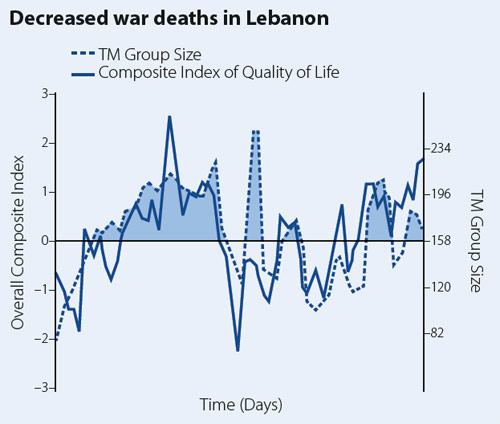
These results were subsequently replicated in nine consecutive experiments over a two-year period during the peak of the Lebanon war. The results of these interventions included:
- war-related fatalities decreased by 71%
- war-related injuries fell by 68%
- the level of conflict dropped by 48%
- cooperation among antagonists increased by 66%
The likelihood that these combined results were due to chance is less than one part in 1019, making this approach of reducing societal stress and conflict the most rigorously established approach in the history of conflict management.
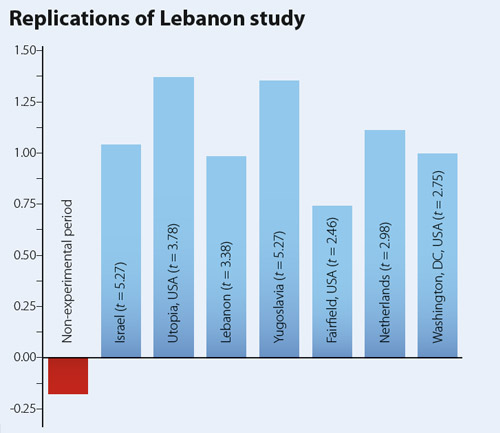
References
Journal of Social Behavior and Personality, 17(1), 285-338, 2005
72% reduction in worldwide terrorism
The global influence on terrorism of three large peace-creating assemblies was studied retrospectively through an analysis of data compiled by the Rand Corporation. The data revealed a 72% reduction in worldwide terrorism during the three assemblies taken together, as compared to all other weeks during a two-year period. Each assembly had approached or exceeded the participation threshold (square root of 1% of the world’s population) predicted to create a global influence of peace. The study ruled out the possibility that this reduction in terrorism was due to cycles, trends, or drifts in the measures used, or to seasonal changes.
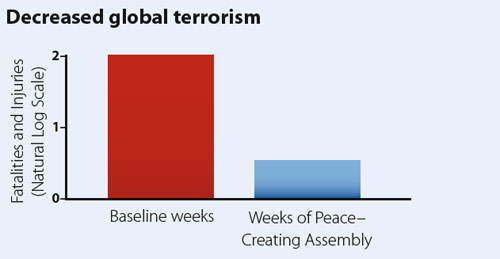
National Demonstration Project
A National Demonstration Project conducted in Washington, D.C., from June 7 to July 30, 1993, tested the efficacy of the Global Peace Initiative’s approach to reducing crime and social stress and improving the effectiveness of government.
In this carefully controlled experiment, the peace-creating group increased from 800 to 4,000 over the two-month period. Although violent crime had been steadily increasing during the first five months of the year, soon after the start of the study, violent crime (measured by FBI Uniform Crime Statistics) began decreasing and continued to drop until the end of the experiment (maximum decrease 23.3%), after which it began to rise again. The likelihood that this result could be attributed to chance variation in crime levels was less than two parts per billion (p < .000000002). The drop in crime could not be attributed to other possible causes, including temperature, precipitation, weekends, and police and community anti-crime activities.
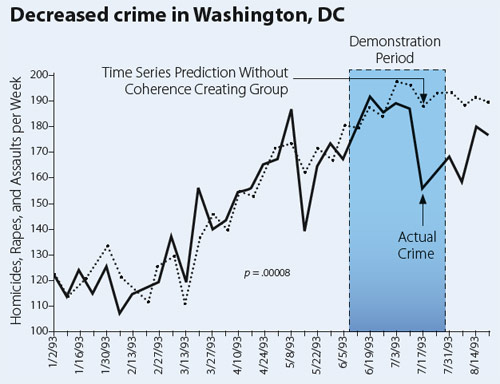
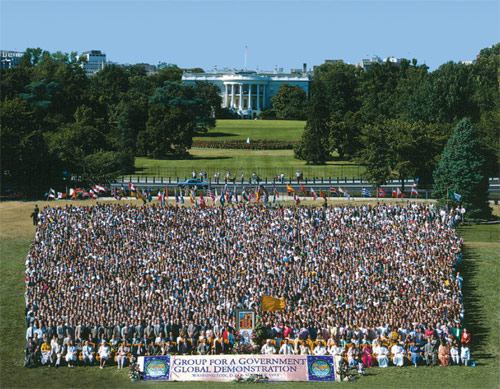
National Demonstration Project
- Borland, C., and Landrith, G.S. (1977). Improved quality of city life through the Transcendental Meditation program: Decreased crime rate. In David Orme-Johnson and John Farrow (Eds.), Scientific Research on the Transcendental Meditation Program: Collected Papers, Vol. 1, 639–648.
- Ibid.
- Dillbeck, M.C., Landrith, G. III, & Orme-Johnson, D.W. (1981). The Transcendental Meditation program and crime rate change in a sample of forty-eight cities. Journal of Crime and Justice, 4, 25–45.
- Dillbeck, M.C., Cavanaugh, K.L., Glenn, T., Orme-Johnson, D.W., & Mittlefehldt, V. (1987). Consciousness as a field: The Transcendental Meditation and TM-Sidhi program and changes in social indicators. Journal of Mind and Behavior, 8(1), 67–104.
- Hagelin, J.S., Orme-Johnson, D.W., Rainforth, M., Cavanaugh, K., & Alexander, C.N. (1999). Results of the National Demonstration Project to Reduce Violent Crime and Improve Governmental Effectiveness in Washington, D.C. Social Indicators Research, 47, 153–201.
- Cavanaugh K.L., & King K.D. (1988). Simultaneous transfer function analysis of Okun’s misery index: improvement in the economic quality of life through Maharishi’s Vedic science and technology of consciousness. Proceedings of the American Statistical Association, Business and Economics Statistics Section (pp. 491–496). Alexandria, Virginia: American Statistical Association.
- Cavanaugh K.L., King K.D., & Ertuna C. (1989). A multiple-input transfer function model of Okun’s misery index: an empirical test of the Maharishi Effect. Proceedings of the American Statistical Association, Business and Economics Statistics Section (pp. 565–570), Alexandria, Virginia: American Statistical Association.
- Orme-Johnson, D.W., Alexander, C.N., Davies, J.L., Chandler, H.M., & Larimore, W.E. (1988). International peace project in the Middle East: The effect of the Maharishi Technology of the Unified Field. Journal of Conflict Resolution, 32(4), 776–812.
- Davies, J.L., & Alexander, C.N. (2005). Alleviating political violence through reducing collective tension: Impact assessment analyses of the Lebanon war. Journal of Social Behavior and Personality, 17(1), 285–338.
- Orme-Johnson, D.W., Dillbeck, M.C., & Alexander, C.N. (2003). Preventing terrorism and international conflict: Effects of large assemblies of participants in the Transcendental Meditation and TM-Sidhi programs. Journal of Offender Rehabilitation, 36 (1-4), 283–302.
- Hagelin, J.S., Orme-Johnson, D.W., Rainforth, M., Cavanaugh, K., & Alexander, C.N. (1999). Results of the National Demonstration Project to Reduce Violent Crime and Improve Governmental Effectiveness in Washington, D.C. Social Indicators Research, 47, 153–201.
- Davies, John L.; and Alexander, Charles N. (2005). Alleviating political violence through reducing collective tension: Impact assessment analyses of the Lebanon war. Journal of Social Behavior and Personality 17: 285–338.
- Orme-Johnson, David W.; Dillbeck, Michael C.; and Alexander, Charles N. (2003). Preventing terrorism and international conflict: Effects of large assemblies of participants in the Transcendental Meditation and TM-Sidhi programs. Journal of Offender Rehabilitation 36: 283–302.
- Orme-Johnson, David W.; Dillbeck, Michael C.; and Alexander, Charles N. (2003). Preventing terrorism and international conflict: Effects of large assemblies of participants in the Transcendental Meditation and TM-Sidhi programs. Journal of Offender Rehabilitation 36: 283–302.
- Orme-Johnson, D. W. (1994). Transcendental Meditation as an epidemiological approach to drug and alcohol abuse: theory, research, and financial impact evaluation. Alcoholism Treatment Quarterly 11: 119–168.
- Hagelin, John S.; Rainforth, Maxwell V.; Orme-Johnson, David W.; Cavanaugh, Kenneth L.; Alexander, Charles N.; Shatkin, Susan F.; Davies, John L.; Hughes, Anne O.; and Ross, Emanuel. (1999). Effects of group practice of the Transcendental Meditation program on preventing violent crime in Washington, DC: Results of the National Demonstration Project, June–July, 1993. Social Indicators Research 47: 153–201.
- Dillbeck, M. C. (1990). Test of a field theory of consciousness and social change: Time series
analysis of participation in the TM-Sidhi program and reduction of violent death in the U.S. Social Indicators Research 22: 399–418. - Assimakis, P. D., and Dillbeck, M. C. (1995). Time series analysis of improved quality of life in Canada: Social change, collective consciousness, and the TM-Sidhi program. Psychological Reports 76: 1171–1193.
- Orme-Johnson, D. W.; Cavanaugh, K. L.; Alexander, C. N.; Gelderloos, P.; Dillbeck, M.; Lanford, A. G.; and Abou Nader, T. M. (1989). Scientific research on Maharishi’s Transcendental Meditation and TM-Sidhi Programme: Collected papers, Vol. 4. Vlodrop, The Netherlands: Maharishi Vedic University Press, 1989, pp. 2730–2762.


